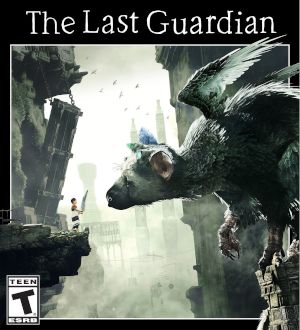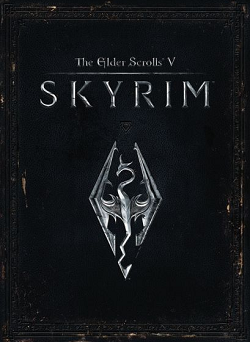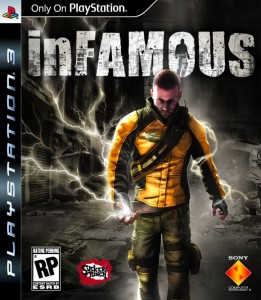written by Melissa Shaw
 The Last Guardian is a gorgeously detailed, thoughtful action-adventure fantasy game. You play a young boy who awakens in a cavern with a large mythical creature who is chained to the floor. As the story progresses, you form a bond with the creature, Trico, as the two of you navigate through environmental puzzles set in enormous, elaborate environments, some of ancient ruins, some of dizzying heights. Sometimes you need Trico’s help to survive or progress through a series of puzzles, and sometimes Trico needs yours.
The Last Guardian is a gorgeously detailed, thoughtful action-adventure fantasy game. You play a young boy who awakens in a cavern with a large mythical creature who is chained to the floor. As the story progresses, you form a bond with the creature, Trico, as the two of you navigate through environmental puzzles set in enormous, elaborate environments, some of ancient ruins, some of dizzying heights. Sometimes you need Trico’s help to survive or progress through a series of puzzles, and sometimes Trico needs yours.
Designed and directed by Fumito Ueda, who brought us the iconic Ico and Shadow of the Colossus, The Last Guardian shows the influences of both of those games, particularly Ico. In this game, however, you leave all the combat to your enormous companion.
Although the game offers you only a small selection of simple gameplay mechanics to find your way through each map, it combines these mechanics in an ingenious variety of ways to create challenging and thought-provoking puzzles. Rarely is the path through an area clear at first glance. Fortunately, the game lets you take your time in most sections, which also enables you to explore the lush maps, some parts of which serve no purpose other than to enhance the sense of grandeur and detail of this world.
One of the most notable aspects of the game is the creature design. It may seem odd to use a word like “realistic” to describe a 20-foot-tall, feathered beast with a doglike face, a catlike body, and glowing blue horns, but Trico scans as a realistic animal, with idiosyncratic but recognizable behaviors. His animation blending is seamless, so nothing interrupts the realism of Trico on-screen. He is an appealing companion, by turns protective, affectionate, curious, and fearful. He grows attached to you, following you around, howling mournfully when you’ve gone somewhere he can’t reach. Although Trico moves like a cat, he isn’t perfect; he sometimes misjudges leaps and has to scramble to complete them. His imperfections make him all the more endearing.
Like any real animal, Trico is not a perfectly controllable creature. He has his own agenda and his own limitations. The game requires patience. It can be difficult to communicate what you want to Trico at first, and even when you can, it can take him a little time to do as you ask. The game also requires you to let go of precise control sometimes, and let Trico find his own way rather than waiting for you to direct him.
This game is not without its frustrations. Camera control is sometimes restricted, making it difficult to see. At other times, the camera moves abruptly from one place to another, often to avoid clipping through solid objects. These movements are jarring, and since you move the player character relative to the camera, they can interfere with gameplay. In addition, the game has an atypical controller scheme, with no option to reconfigure it or to reassign buttons. And although it’s a virtue that it is difficult to fall off Trico inadvertently, the flip side of that is that it can be difficult to jump or drop from Trico when you want to. In terms of the story, near the end of the game, there’s a brutal and disturbing cut-scene that’s hard to watch, and another cut-scene that leaves you wondering what you’ve been feeding your friend.
On the whole, though, The Last Guardian is a magnificent game: often quiet and moving, sometimes abruptly exciting, always immersive and beautiful.
 Melissa Shaw’s short fiction has appeared in Asimov’s, Realms of Fantasy, Analog, and several anthologies. Melissa is a Clarion West graduate and a “Writers of the Future” contest winner. She is currently writing for an as-yet-unreleased video game.
Melissa Shaw’s short fiction has appeared in Asimov’s, Realms of Fantasy, Analog, and several anthologies. Melissa is a Clarion West graduate and a “Writers of the Future” contest winner. She is currently writing for an as-yet-unreleased video game.

 I’m not a patient gamer. When I sit down with a new game, I want to dive into the action, run around the world taking in the sights, learn (and use) some skills, and get introduced to and led through a compelling story that doesn’t make me sit still for too long at a time. Which is why I have often avoided RPGs in the past.
I’m not a patient gamer. When I sit down with a new game, I want to dive into the action, run around the world taking in the sights, learn (and use) some skills, and get introduced to and led through a compelling story that doesn’t make me sit still for too long at a time. Which is why I have often avoided RPGs in the past.


 From top to bottom, Batman: Arkham Asylum for the Sony PS3 is a vivid, detailed, and sometimes chilling foray into the gothic world of Batman.
From top to bottom, Batman: Arkham Asylum for the Sony PS3 is a vivid, detailed, and sometimes chilling foray into the gothic world of Batman. Written by Melissa Shaw
Written by Melissa Shaw